You are viewing 1 of your 1 free articles
Attacking through central areas
This session is designed with the players’ individual development needs in mind. I have a passion for developing the individual within a team environment and recreating the moments of the game the players will be exposed to informs a lot of my practice design.
| Area | Up to full pitch |
| Equipment | Ball, bibs, cones, 2 full size goals, mannequins |
| No. of Players | Up to 20 players + 2 goalkeepers |
| Session Time |
Warm-up: 20mins Central combinations: 20mins Central combinations game: 20mins 11v11: 24mins |
This session is designed with the players’ individual development needs in mind. I have a passion for developing the individual within a team environment and recreating the moments of the game the players will be exposed to informs a lot of my practice design.
The modern player demands the position-specific work their performances will be judged on, so the aim of this practice is to make it as specific and personally engaging as possible for the individual.
The group I focus on in the session are the forward players: a central striker, two narrow wide players and an attacking midfielder. The objective of the session is to develop the technical skills for attacking in central areas and the relationships and connections between this group of players.
The session starts with an unopposed finishing practice, with two groups alternating. Having two groups pitched against each other creates a greater intensity and competitive environment.
The session then progresses to a central combinations game, before finishing with an 11v11 on a narrow pitch.
There are several factors to be considered when designing a training week. Is it a senior environment based on results? Is it a development environment based on getting your best young players through?
Depending on the games schedule, and if it was a clear, one game week, I prefer to incorporate position-specific work into a training week at least twice.
If there was a midweek fixture, I would still run one position-specific training session per week, but the volume and intensity of the repetitions must be managed based on individual needs.
CENTRAL COMBINATIONS
After a 20-minute warm-up [not shown], we set up on half a pitch with a full size goal and goalkeeper at the end. Five mannequins are set out across the area as shown.
We’re using eight outfield players split into two teams of four. Each team has a striker, an attacking midfielder, and two wingers.
The red team starts and runs through five different combinations.
We’re looking for intensity and realism of the practice.
Double movements to receive, firm safe-side passes that are smooth to the floor, soft sets, timing and speed of runs, quality of finish and high tempo work and moving onto the next ball quickly are all elements we like to see in practices of this type and we challenge the players to deliver them.
In the first combination, the coach plays a square pass to the striker, who receives by taking a first touch beyond the mannequin and finishes, as shown [1a].
[1A]
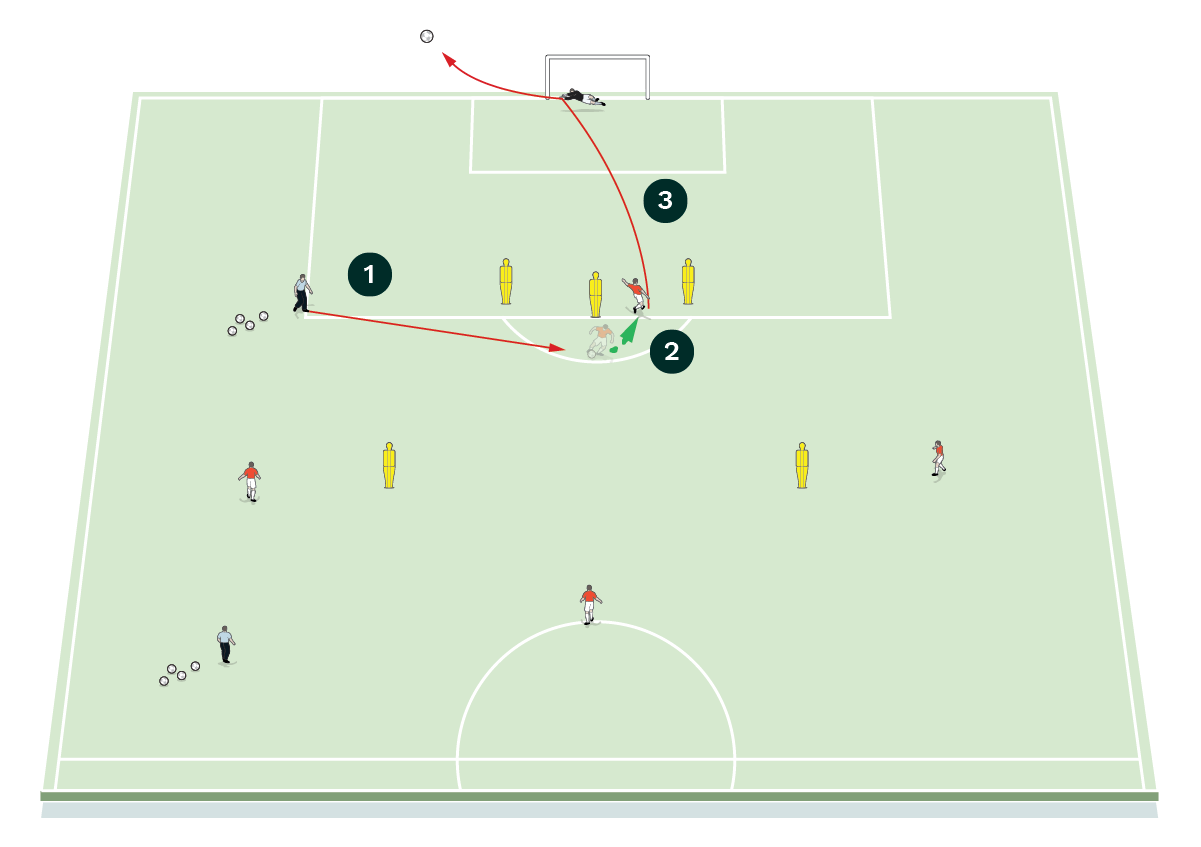
-
The coach plays a square pass to the striker
-
The striker takes a first touch beyond the mannequin
-
The striker shoots at goal and scores
The second combination sees the coach play a ball into the attacking midfielder, who receives it on the half turn. The right winger travels inside quickly to receive a soft pass from the attacking midfielder. The winger plays a firm pass to the striker, then begins an overlap run.
The left winger moves to support underneath the ball and receives a set back from the striker. The left winger then plays a through ball to meet the right winger on the overlap. The right winger finishes, as shown [1b].
[1B]
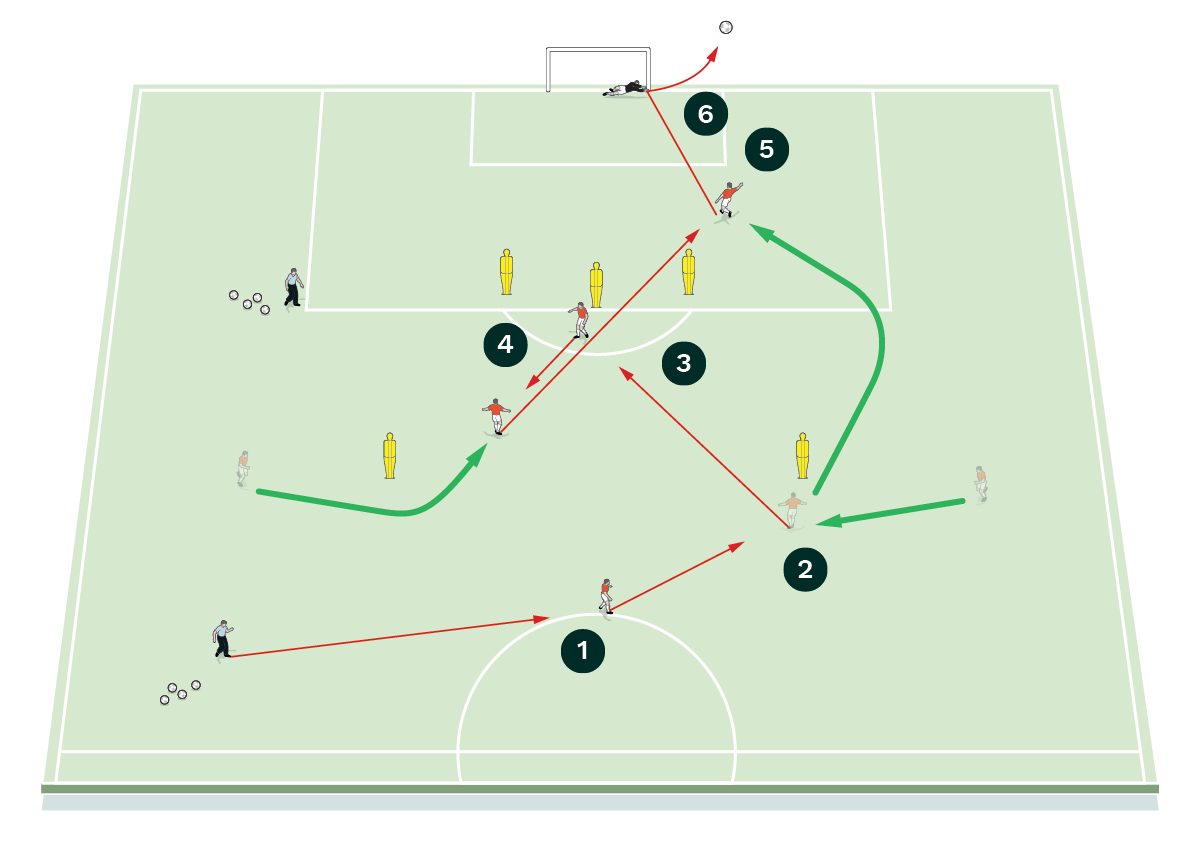
-
The coach plays a ball into the attacking midfielder who receives it on the half turn
-
The right winger travels inside quickly to receive a soft pass from the attacking midfielder
-
The winger plays a firm pass to the striker then begins an overlap run
-
The left winger moves to support underneath the ball and receives a set back from the striker
-
The winger plays a through ball to meet the right winger on the overlap
-
The right winger finishes
In the third combination, the coach plays a ball into the attacking midfielder, who plays a firm pass on to the striker. The striker sets the ball for the left winger to run onto and take a one touch finish, as shown [1c].
[1C]
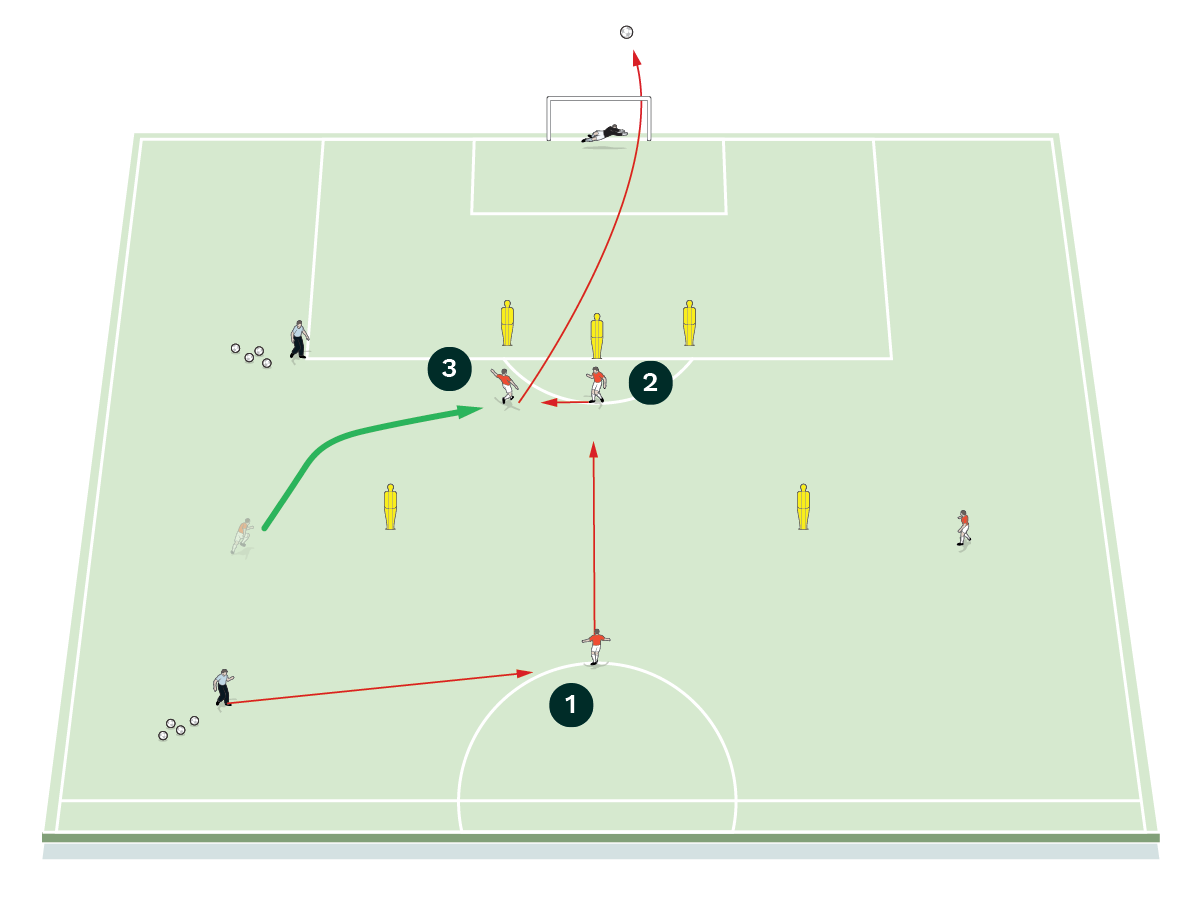
-
The coach plays a ball into the attacking midfielder
-
The midfielder plays a firm pass on to the striker
-
The striker sets the ball for the left winger to run onto and take a one touch finish
In the fourth combination, the wingers start further forward, now on the line of the penalty box. The play starts with the coach playing a firm pass into the striker who plays the ball for the attacking midfielder to run onto. The midfielder plays a pass through the mannequins to the right midfielder who has made a run to receive it in an area called the cut back zone.
The left winger and striker make interchanging runs and double movements. The right winger crosses the ball and the left winger connects with it to get a shot off, as shown [1d].
[1D]
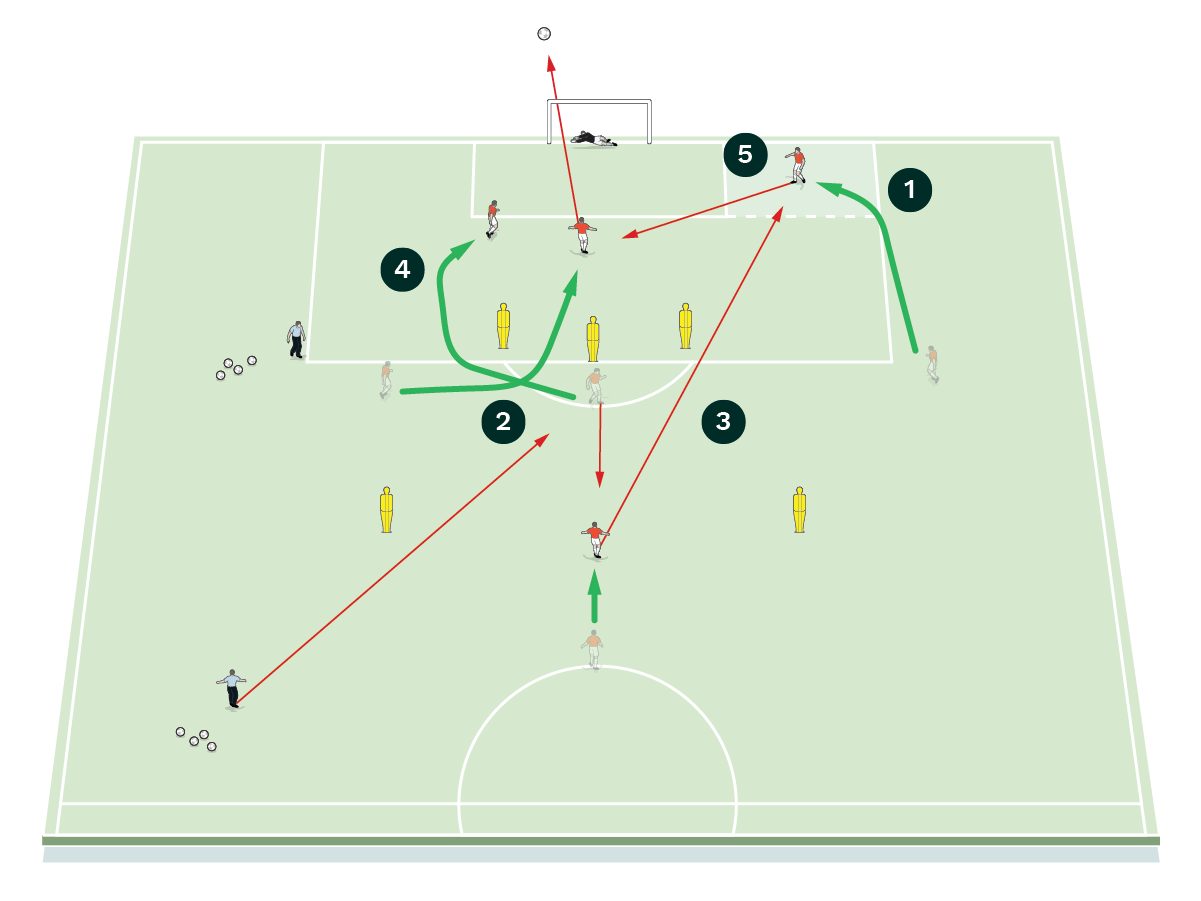
-
The two wingers start further forward, now on the line of the penalty box
-
The play starts with the coach playing a firm pass into the striker who plays the ball for the attacking midfielder to run onto
-
The midfielder plays a pass through the mannequins to the right midfielder who has made a run to receive it in an area called the cut back zone
-
The left winger and striker make interchanging runs and double movements
-
The right winger crosses the ball and the left winger connects with it to get a shot off
In the final combination, the striker and two wingers move out of play. The coach plays a square pass for the attacking midfielder to run onto. The midfielder uses their first touch to manipulate a shooting line and their second to finish, as shown [1e].
[1E]
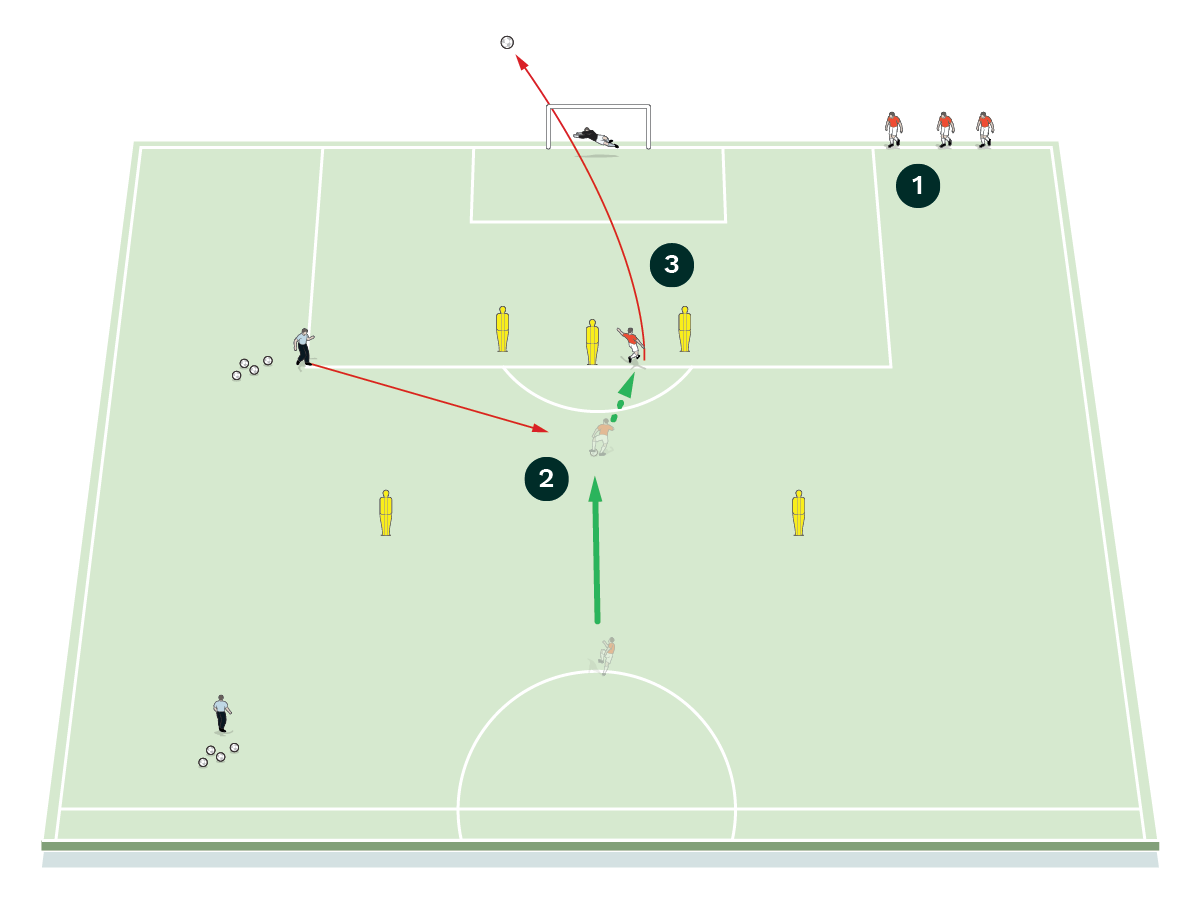
-
The striker and two wingers have moved out of play
-
The coach plays a square pass for the attacking midfielder to run on to
-
The midfielder uses their first touch to manipulate a shooting line, and their second to finish
The red team then swap out and the blue team swap in to run through the same five combinations. Goalkeepers also rotate. We would continue to rotate, running these combinations for a total of 20 minutes.
While this practice is taking place, the central defenders and midfielders are involved in a technical passing session and both sets of full backs are involved in a 1v1 attacking and defending practice.
CENTRAL COMBINATIONS GAME
We set up on three quarters of a pitch with a full size goal and goalkeeper at each end. A hexagonal area, with sides 20 yards long, is marked out from the edge of the penalty box. This area is split into three sections – a central zone and two end zones. A second penalty box is marked out between the halfway line and the end line.
We’re using 17 outfield players. In one end zone there is a blue striker, attacking midfielder and two wingers against three red defenders, and in the other end zone, the reds have the same attacking positions against three blue defenders. In the middle zone, there are three midfielders in a 2v1 – two yellows and one green.
The coach plays the ball to one of the yellow players in the central zone to start the play. This midfielder looks to play forwards into an attacking area for the blues to attack. The green midfielder presses to win the ball back.
The blues must then look to execute one of the combinations from the first practice to score a goal. The reds defend this, as shown [2a].
[2a]
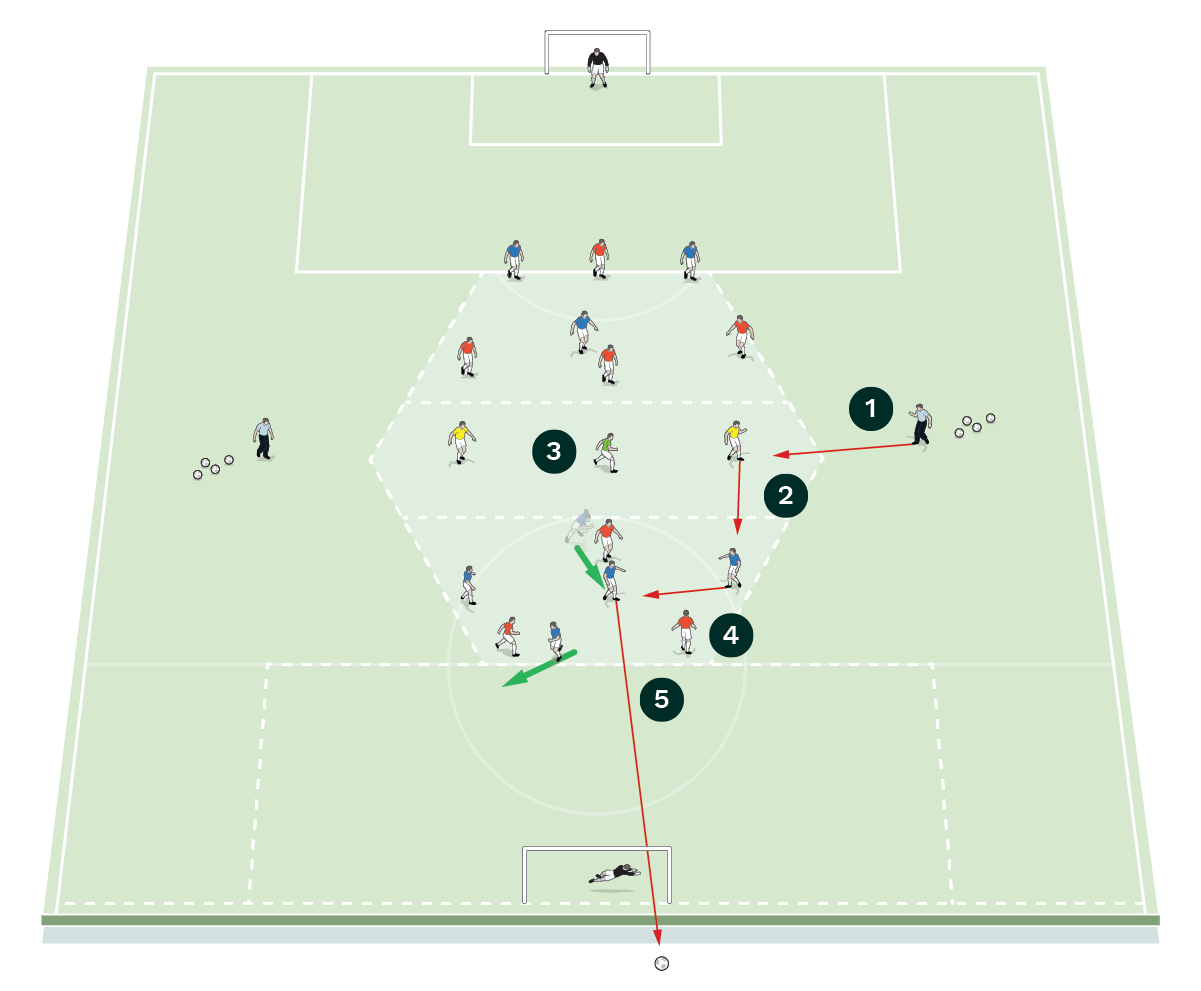
-
The coach plays the ball to one of the yellow midfielders in the central zone to start the play
-
The midfielder looks to play forwards into an attacking area for the blues to attack
-
The green midfielder presses to win the ball back
-
The winger plays a square ball for the attacking midfielder to run onto
-
The attacking midfielder shoots
The blues can play back to the yellow midfielders in the middle zone once to reset if needed. If this is done more than once, the midfielder must turn and play in the opposite attacking team, the reds in the other end zone, as shown [2b].
[2b]
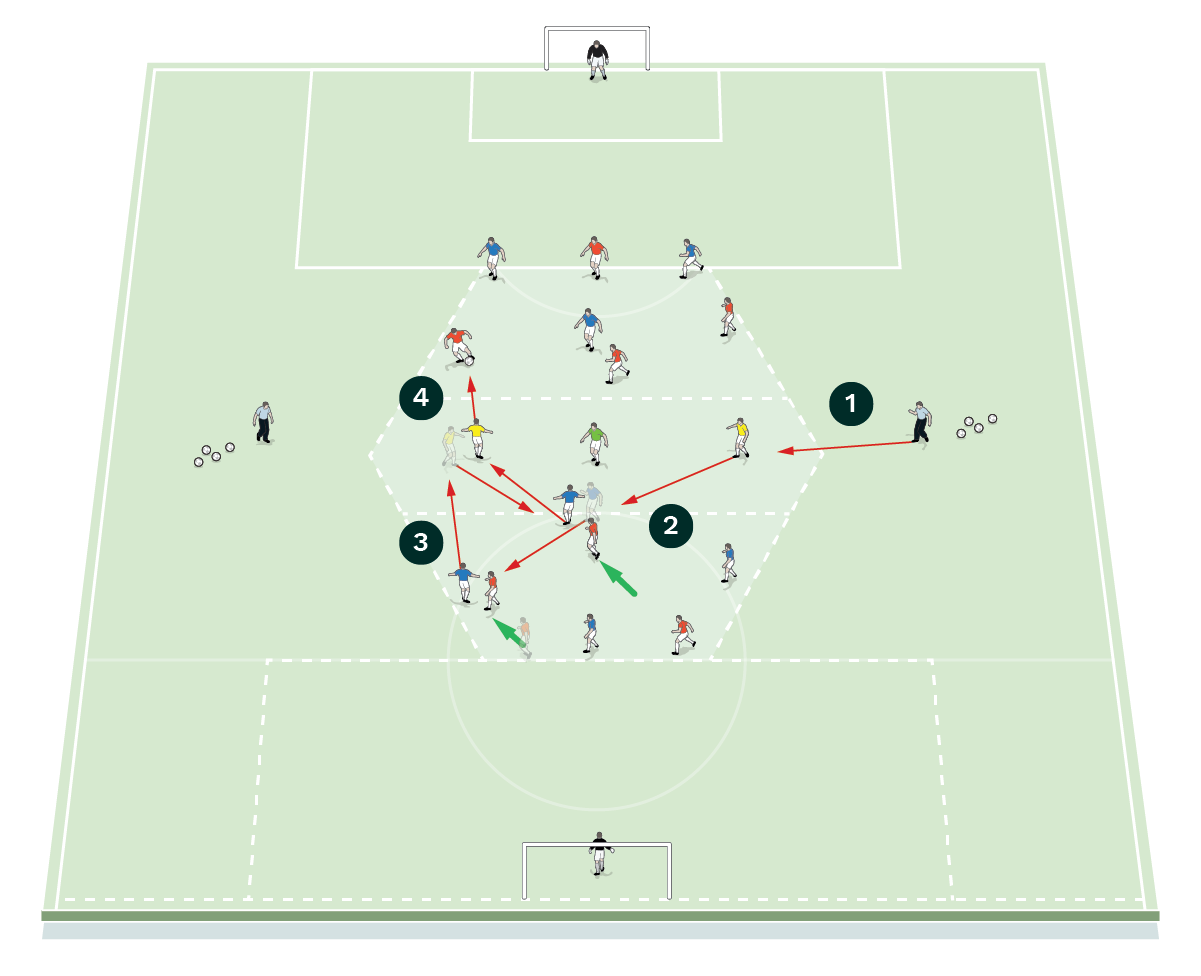
-
The coach starts play by passing the ball to a yellow who plays it into a blue attacker
-
The attacker plays the ball back to the other midfielder in the middle zone and receives it back
-
The attacker plays it to the winger who is under pressure from a defender and so plays it back to the yellow
-
The yellow switches the attack to the other end zone
If the defending team win the ball, they must look to find the yellow midfield two who can then transfer the ball to the attackers in the other end zone. The attacking team should respond quickly to losing the ball, counter-pressing to win it high and create chances, as shown [2c].
[2c]
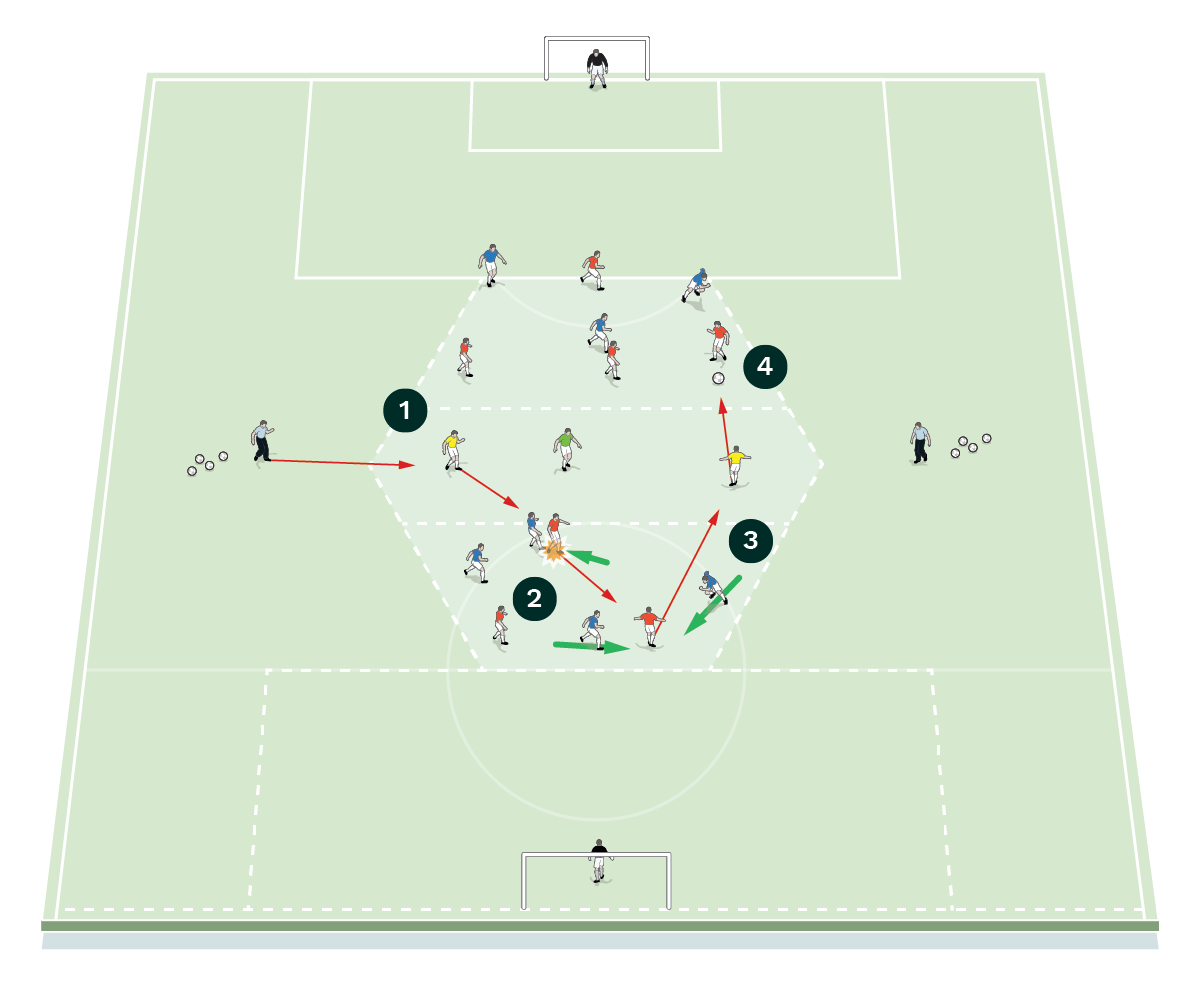
-
The coach plays the ball into a yellow in the middle zone
-
A midfielder receives it from the yellow but is challenged by a defender
-
The defender plays the ball back to their teammate who works it out to a yellow in the middle zone
-
The yellow plays the ball to the other side to start a red attack
We would spend around 20 minutes on this practice, splitting it into three blocks of work, the time of which is dependent on where the day sits in the training week. The defending midfielder is rotated after each block.
NARROW 11V11
We set up on a full pitch coned off to 60-yards, with a full-size goal and goalkeeper at each end.
We’re using 20 outfield players, split into two teams. The reds and blues face each other. Each team sets up with two wingers, an attacking midfielder and a striker. The teams are tasked with using one of the combinations from the first practice to score a goal, as shown [3].
[3]
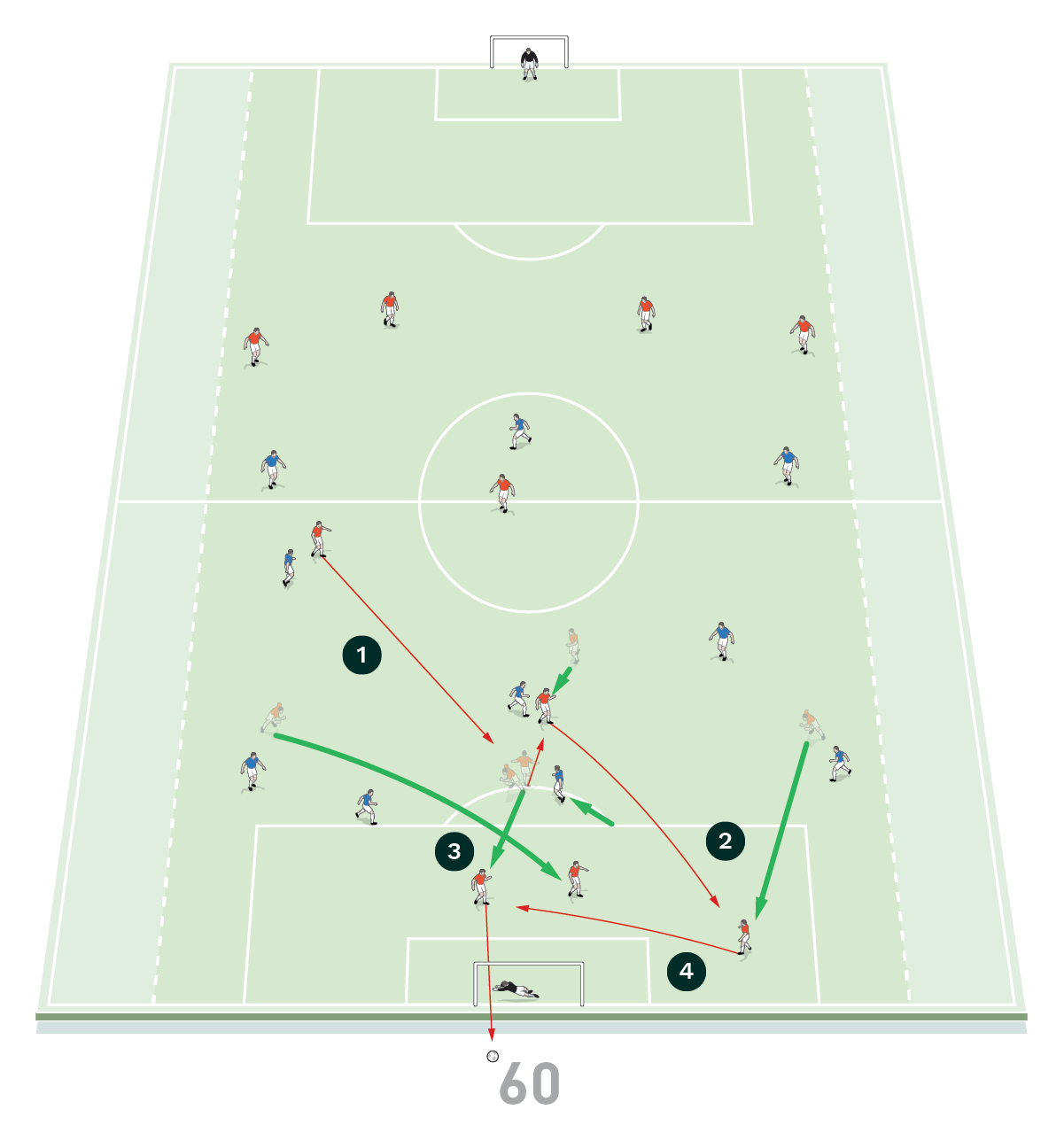
-
The red midfielder is in possession and plays the ball to the striker who sets it off for the attacking midfielder to run onto
-
The attacking midfielder plays the ball into the cutback zone where the left winger has made a run
-
The right winger and attacker make cross runs
-
The winger cuts the ball back for the attacker to run onto and finish
We would play this for two blocks of 12 minutes.
What are the key things to look out for?
In this session I’m looking for high levels of detail in the combination play between the forwards. Passes on the floor where possible is something I like to be consistent with, as well as safe side passing to keep the ball away from defenders.
The timing of movement so that the players “arrive and don’t wait”, as well as someone always looking to affect the back line, are also important principles.
Then, it’s about the end product. As this session is focused on the business end of the pitch, the quality of the final action will deem whether or not the move has been successful, so the composure to score in the moment is critical.
What are the typical mistakes players might make and how can they be avoided?
Depending on the individual motivation of the players, there is always a risk that unopposed practices can create sloppy play in terms of their movements and pass detail.
Before starting the practice, I always tell the players that I am looking for high energy, high enthusiasm and high quality in all of their actions. I then continue to drive the intensity through the practice.
Creating forfeits for slow passes or non-safe side passes can also result in greater focus from the individual player.
Related Files

Rhys Carr
Editor's Picks
Deep runs in the final third
Using the goalkeeper in build-up play
Pressing principles
Intensive boxes drill with goals
Penetrating the final third
Creating and finishing
My philosophy
Pressing initiation
Compact team movement
Coaches' Testimonials

Alan Pardew

Arsène Wenger

Brendan Rodgers

Carlos Carvalhal

José Mourinho

Jürgen Klopp

Pep Guardiola

Roy Hodgson

Sir Alex Ferguson

Steven Gerrard
Coaches' Testimonials

Gerald Kearney, Downtown Las Vegas Soccer Club

Paul Butler, Florida, USA

Rick Shields, Springboro, USA

Tony Green, Pierrefonds Titans, Quebec, Canada
Join the world's leading coaches and managers and discover for yourself one of the best kept secrets in coaching. No other training tool on the planet is written or read by the calibre of names you’ll find in Elite Soccer.
In a recent survey 92% of subscribers said Elite Soccer makes them more confident, 89% said it makes them a more effective coach and 91% said it makes them more inspired.
Get Monthly Inspiration
All the latest techniques and approaches
Since 2010 Elite Soccer has given subscribers exclusive insight into the training ground practices of the world’s best coaches. Published in partnership with the League Managers Association we have unparalleled access to the leading lights in the English leagues, as well as a host of international managers.
Elite Soccer exclusively features sessions written by the coaches themselves. There are no observed sessions and no sessions “in the style of”, just first-hand advice delivered direct to you from the coach.








